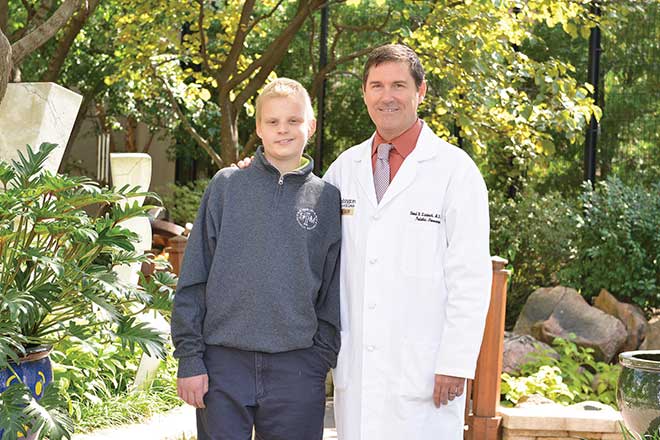When Brett Haubrich was diagnosed with a Grade 3 malignant brain tumor in June 2014, his parents listened carefully to the prognosis and plans laid out by St. Louis Children’s Hospital. Their son was only 11 years old, and it was not easy to accept what they were hearing: Only 20 percent of people diagnosed with Brett’s tumor live three years.
“I got four or five second opinions, and I was amazed to find out the hospital with the top technology was Children’s Hospital, which was only 20 minutes from our house,” Brett’s mom Eileen Haubrich says. “We just hoped and prayed it would work.”
Eileen Haubrich was relieved about the new option, and her son underwent his first LITT surgery on Jan. 5 and a second one March 29. Limbrick and Leuthardt performed the surgery together. “I knew we were up against a bad tumor,” Eileen says. “It grows back quickly. I knew our options were limited, but I completely trust Dr. Limbrick, who I believe is top in his field. And I don’t have enough kind words to say about Dr. Leuthardt, who learned the process so he could do this for kids.”
There was concern Brett would be paralyzed during the procedures because of where the tumor was located. However, the surgeries were successful and left Brett only with weakness in his right arm and right leg. “The success has been amazing,” Limbrick says. “We have been using it for a year on inoperable brain tumors and regions of the brain that cause epilepsy.”
Limbrick says currently no tumor appears in images of Brett’s brain. The now 13-year-old still has oral chemo 24 days a month but is determined to do normal kid things. He even played baseball in the spring. “The surgery has made a major impact on his life,” his mom says. “It has improved his quality of life, and maybe it can extend his life so he can be ready for another advancement. I can smile now and relax a little between scans and forget what I was initially told.”
She takes comfort in knowing Children’s Hospital continues to look at all the technological advancements. “I feel like they are looking out for us, and when I ask them about new technology or trials, they get back to me quickly,” she says. “I’m confident Brett is not slipping through the cracks there.”
Pictured: Brett Haubrich and Dr. David Limbrick
Photo: Bill Barrett
The specialized expertise of the pediatric neuro-oncology team at St. Louis Children’s Hospital offers cutting-edge treatments for brain tumors. Pictured on the cover: Dr. Eric Leuthardt, professor of neurological surgery at Washington University School of Medicine, patient Brett Haubrich and Dr. David Limbrick, neurosurgeon-in-chief at St. Louis Children’s Hospital and chief of pediatric neurosurgery at Washington University School of Medicine. For more information, call 314.454.KIDS or visit stlouischildrens.org.
Cover design by Jon Fogel | Cover photo by Bill Barrett
